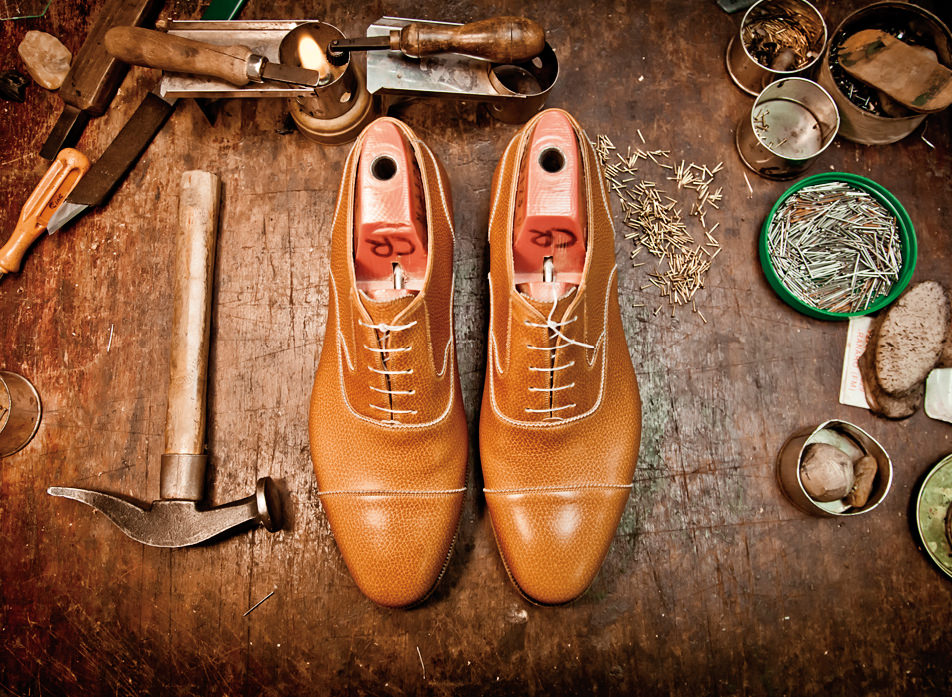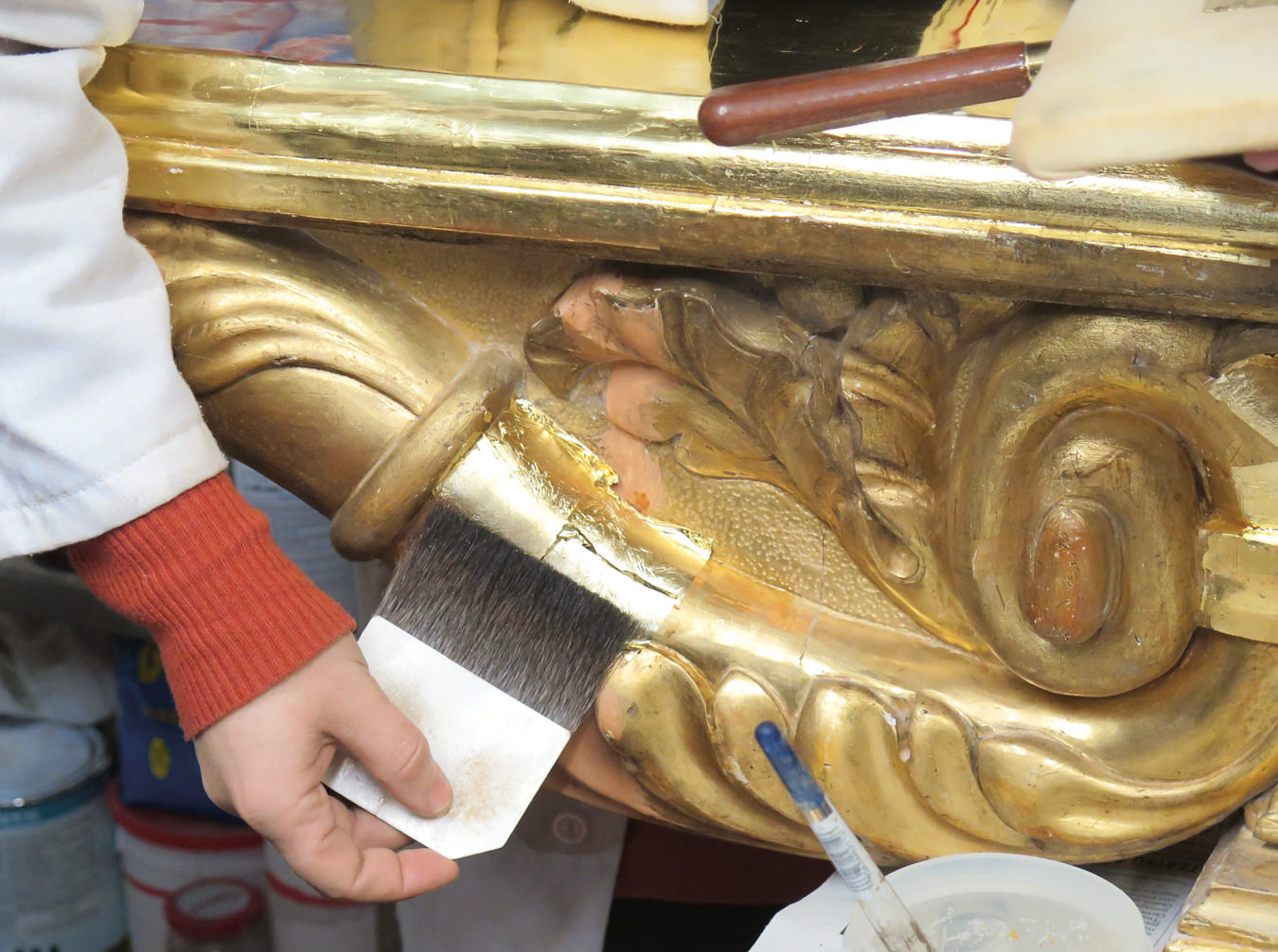-

At No. 26 on Via dell’Orso in Rome, behind an unadorned and unmarked entrance, is Laboratorio Piovano, where hidden treasures lurk.
-

Michela Piovano specializes in gilding and restoring decorative works.
-

Years of activity have transpired at Laboratorio Piovano; work for distinguished patrons along with the most renowned of institutions.
-

Micromosaics are an assemblage of thousands of tesserae—microscopically small marble, glass, tile, or rock.
-

Italy is renowned for its artisans, who create unique masterpieces by hand, but practitioners of fading art forms are a rare breed.
-

At Laboratorio Piovano one finds the confusion of true artists.
Artisanal Craft in Rome
The Piovano family of restorers.
The past few decades have been rough on the wood carvers, sculptors, gilders, goldsmiths, engravers, and furniture makers whose work has beautified many of Europe’s great monuments. Once big business, the crafts that contributed to Italy’s ascent are now disappearing; many artisans have packed up their tools. But a few still remain, clinging to the traditional skills in their centuries-old workshops. In a small bottega on Via dell’Orso in Rome, Vincenzo Piovano, along with his daughters Michela and Alessandra, plies trades handed down to him through the generations.
At No. 26, behind an unadorned and unmarked entrance: frames leaning against walls, mosaic tiles ready to create new figures, volumes of art and architecture books, a console of the Boncompagni family. Hidden treasures lurk here. Years of activity have transpired at this Roman workshop—work for distinguished patrons along with the most renowned of institutions.
Vincenzo, a carver and sculptor, grew up in an artisanal world. “Papà è un ragazzo di bottega [My father is a workshop boy],” says Michela, the eldest of the sisters. “He grew up watching his father, who grew up watching his father,” she explains in Italian of her family of restorers, which was originally from Priverno, a town 100 kilometres south of Rome. Vincenzo moved to Rome with his family when he was 12 and found work with a master carver. On his first day, he watched the sculpting of a statue of Saint Gabriel. “At the time, artisanal work was transmitted through apprenticeship. Teaching was immersion,” says Michela. School for this work cannot be done in a classroom. Vincenzo picked up the know-how and nuances with first-hand engagement. “Artisanal work is an art. The earlier you begin, the better you are. You need to be predisposed to the craft and then have it fostered.”
Italy is renowned for its artisans, who create unique masterpieces by hand. But the Michelangelos of the handcrafted arts are at risk of disappearing. Practitioners of fading art forms like Vincenzo are a rare breed—he is one of only a handful of intagliatori left in Rome. Italians, despite a high unemployment rate (nearly 40 per cent of young people are currently out of work), aren’t learning these crafts anymore. Aging artisans simply can’t afford to pass along their knowledge (apprenticing in workshops used to be unpaid, impossible under today’s labour laws). And due to Italy’s legendary bureaucracy, hiring an apprentice is an expensive endeavour.
“The true treasure of Italy is the artisan. Rome isn’t just about the sights of the city, but the fruit of the artisans.”
Michela, 43, and Alessandra, 40, spent their early years at their father’s side, watching him work. “The work of an artigiano is something that has to grow within you,” says Alessandra. And what Vincenzo saw in his daughters was a passion for craft, steering each to nurture their own loves. The sisters are now part of the family business, each specializing in her own field: Alessandra restores and creates micromosaics (an assemblage of thousands of tesserae) while Michela focuses on gilding and restoring decorative works. At 69, Vincenzo continues carving.
Says Michela, “Our father always tells us, ‘You don’t do this for money. From this workshop, only the best work is to result. Even if you have to invest the time and resources when it no longer makes economical sense, you create perfection. Monetary gain does not dictate.’ ” This fundamental principle is what guides Michela and Alessandra, and the end product displays a precision of craft so beautiful, it stirs emotion.
“The true treasure of Italy is the artisan. Rome isn’t just about the sights of the city, but the fruit of the artisans,” states Michela. There are signs that perhaps those in government are taking heed. The chamber of commerce in Rome and the Roman Institute for Entrepreneurial Training have developed Eccellenze Romane per l’Export, a project that aims to promote the excellence of Roman artisans.
“Artisans are like a chain,” says Michela. “If you remove one piece, it’s broken.” The Piovano trio labours on for a roster of museums, galleries, churches (as well as Vatican City), palaces, and international clients that have sought them out. Michela was recently in Paris, gilding the ceiling above a swimming pool in a château owned by an Arab prince. “I spent an entire month staring up at a ceiling,” she jokes.
“We will never say no to a project based on the level of difficulty,” adds Alessandra. “We enjoy the challenge. What we need is time.” Bear in mind, Rome wasn’t built in a day.



